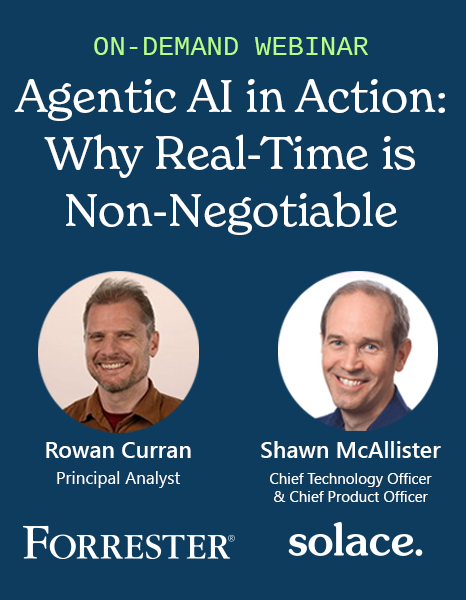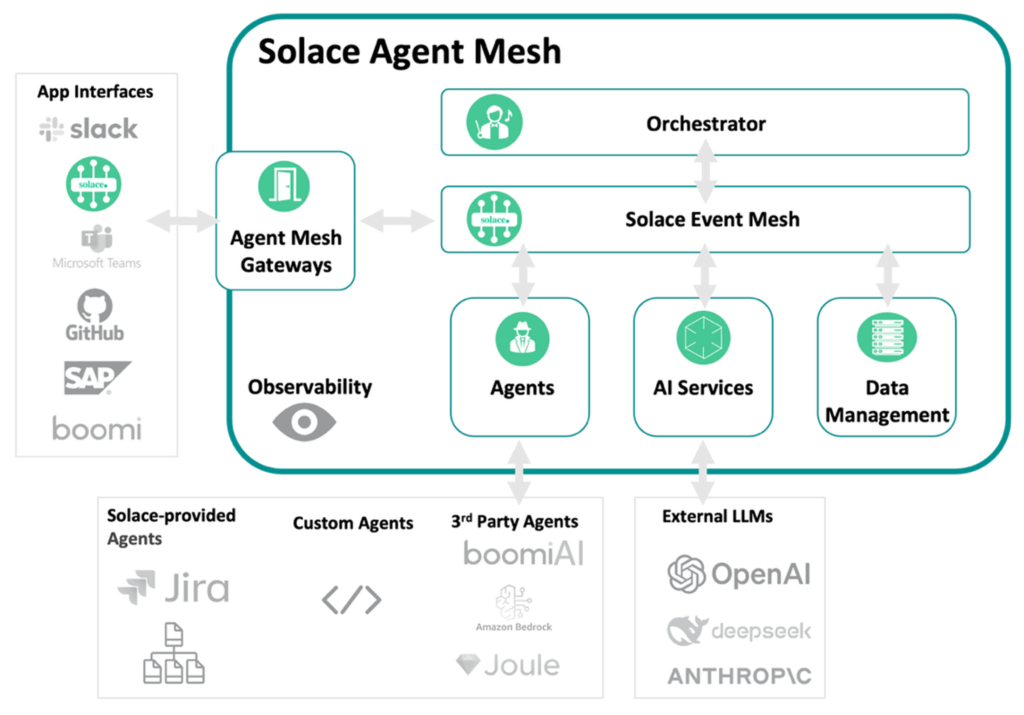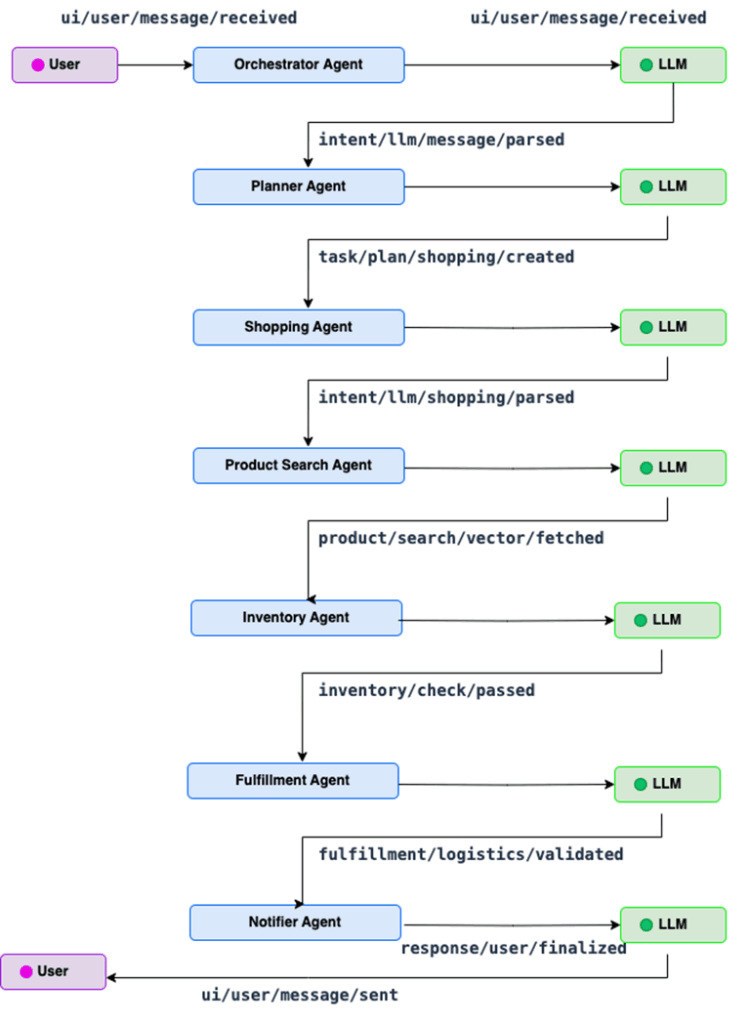Home > Blog > Artificial Intelligence
Subscribe to Our Blog
Get the latest trends, solutions, and insights into the event-driven future every week.
Thanks for subscribing.
For over five decades, systems followed a predictable pattern: a client makes a request, a server responds. That model shaped everything – from application architecture to cloud infrastructure. Since the year 2000, an increasing number of industries have shifted to an event-driven approach where information is distributed in real-time as things happen.
In the world of AI, agents, and dynamic coordination, event-driven architecture is a necessity. That’s because today’s systems must do more than respond. They must understand, reason, and act – often in distributed, asynchronous, and recursive ways. To facilitate this, you must think beyond request/reply and even standard EDA, you need what I call intent streams
Intent streams are event flows where the payload carries not just data, but semantic meaning about goals, context, and expected outcomes. While not yet a formal industry standard, this term draws inspiration from reactive UI design and AI-native workflows, where flows are increasingly shaped by purpose, not just payloads.
Intent streams embed not just what happened but what should happen next. By making intent a first-class citizen in the event flow, they elevate systems from simple notification to collaborative reasoning and adaptive decision-making. In doing so, intent streams power orchestration.
In this blog, we’ll explore the architectural shift from static emitters and consumers to dynamic, agentic coordination – and how Solace Agent Mesh turns this concept into an enterprise-ready implementation.
From Emitters to Effectors: Upstream/Downstream in EDA
Event-driven architecture (EDA) disrupted the request-response paradigm by decoupling the sender from the receiver. In EDA:
- A publisher emits an event – a fact, signal, or intent.
- Any number of subscribers can react asynchronously.
For example, in an e-commerce system:
- retail/order/placed is published by the Order Service
- fulfillment/initiated is triggered by the Fulfillment Service
Here, upstream refers to the service declaring the business fact; downstream refers to those acting upon it.
This decoupling allows:
- Clear data ownership
- Predictable change impact
- Governance via publish/subscribe contracts
- Resilience via replay-ability
- Better observability across domains
The Evolution of Flow: From APIs to Agentic Behavior
This diagram shows how the way information flows between distributed systems has evolved over the decades.
Let’s chart the architectural transition:
| Stage | Flow Style | Control | Flow Unit | Limitations |
| Monolith | Hardcoded | Local | Functions | Rigid, coupled |
| API-Centric | Exposed | Centralized | Endpoints | Synchronous, brittle |
| Event-Driven | Decoupled | Reactive | Events | Stateless, human-defined semantics |
| Event Mesh | Distributed | Declarative | Topics | Hard to model cross-domain logic |
| Agent Mesh | Adaptive | Delegated | Intents | Complex observability, role fluidity |
Flow is no longer just about transporting data – it’s the new abstraction layer for behavior, delegation, and collaborative system intelligence.
Enter the Agent Mesh: Where Flow Becomes Intent-Driven
An agent mesh is an architectural pattern designed to enable coordinated, autonomous communication between multiple AI agents over a decentralized, event-driven infrastructure.
In systems powered by LLMs and AI agents:
- Events aren’t just signals – they carry semantic intent.
- Agents interpret, deconstruct, and act on goals – then hand off follow-up tasks.
- Coordination happens without central orchestration.
| Feature | Traditional EDA | Agent Mesh (Agentic AI) |
| Role Assignment | Static per service | Contextual & evolving |
| Data Model | Schema-first | Intent-first, semantic |
| Flow Direction | Unidirectional | Recursive, adaptive |
| Control Model | Orchestrated | Delegated, emergent |
| Observability | Logs, traces | Flow tracing, context IDs |
This enables systems where components don’t just execute – they reason and evolve.
The question isn’t whether agent meshes represent the future of distributed AI systems—it’s how to get there from where you are today.
Most organizations already have EDA in place, handling everything from user interactions to payment processing. The challenge is evolving these existing systems to harness the reasoning capabilities of AI agents without starting from scratch.
The good news? You don’t need to rebuild everything. Here’s how to bridge the gap:
- Assess Current State
- Is your current event mesh domain-aligned?
- Are topic hierarchies semantically expressive?
- Identify Agent Candidates
- Start with decision-heavy, human-in-the-loop processes
- Good candidates: approvals, exception workflows, task planning
- Pilot in a Bounded Context
- Choose a self-contained domain (e.g., travel booking, order validation)
- Establish Governance
- Define agent scopes, escalation paths, fallback policies, and ACLs
- Scale Gradually
- Expand to cross-domain agent interaction and orchestration
From Event Mesh to Agent Mesh: Solace Agent Mesh in Focus
Solace Agent Mesh builds on the idea of an event mesh to deliver a production-ready implementation of intent-based, agentic coordination.
| Principle | Solace Agent Mesh Implementation |
| Intent-Centric Flow | Semantic topics (intent/, task/, <agent>/) represent agent goals and roles |
| Dynamic Role Assignment | Agents can be upstream or downstream in different contexts – determined by conversation state |
| Loose Coupling via Events | Asynchronous communication via event mesh eliminates hard dependencies |
| Replay & Resilience | Supports replay, retries, and escalation through persistent message history |
| Observability | Correlation IDs (intentId, taskId) enable full semantic traceability |
| Governance & Control | Topic-level ACLs, domain boundaries, and identity-aware gateways |
| Plug-in Intelligence | Agents invoke reasoning, planning, or tools without being tied to a specific model or provider |
Solace Agent Mesh transforms static event consumption into adaptive, goal-driven interaction, bridging the gap from legacy EDA to intelligent, agentic systems.
A Real-World Example: AI Shopping Assistant
Imagine a user type: “Find me a waterproof smartwatch under ₹10,000, deliverable to Bangalore by tomorrow.”
Here’s how an agent mesh might respond:
| Step | Component | Event Topic | Role |
| 1 | Web Chat Gateway | ui/user/message/received | Upstream trigger |
| 2 | Planner Agent | task/plan/shopping/created | Upstream |
| 3 | Shopping Agent | intent/llm/shopping/parsed | Upstream |
| 4 | Product Search Agent | product/search/vector/fetched | Downstream |
| 5 | Inventory Agent | inventory/check/stocked | Downstream |
| 6 | Fulfillment Agent | fulfillment/logistics/validated | Downstream |
| 7 | Notifier Agent | response/user/finalized | Upstream |
| 8 | Web Chat Gateway | ui/user/message/sent | Final response |
Note:
- The LLM is downstream of the UI but upstream to the planner
- The Notifier becomes upstream when it emits the result
Flow is defined by intent and fulfillment, not static roles.
Addressing the Complexity of Agent Mesh
While an agent mesh unlocks powerful new capabilities, it also introduces enterprise challenges that traditional EDA doesn’t face. Solace Agent Mesh addresses these challenges through purpose-built solutions that transform potential weaknesses into operational strengths.
Mastering Observability Complexity
The recursive, adaptive nature of agent flows creates observability challenges that go far beyond traditional event monitoring. Because all communication flows through the event broker, you can monitor and debug the entire system in real-time through Solace Agent Mesh’s comprehensive approach:
- Multi-Dimensional Tracing: Native OpenTelemetry implementation enables end-to-end visibility across intent flows, task delegations, and recursive agent conversations.
- Semantic Context Preservation: Correlation IDs (intentId, taskId, parentTaskId, causationId) trace not just data flow, but the reasoning chain behind agent decisions.
- Wildcard Intelligence: Capture agent interactions into data lakes and visualize real-time communication patterns to understand emergent agent behaviors.
Governing Agent Coordination at Scale
The challenge of managing hundreds of agents with “contextual & evolving” roles requires governance frameworks that traditional EDA governance can’t address.
- Role-Based Security Boundaries: Agent Mesh Gateway provides authentication, authorization, and role-based guardrails with SSO integration and strict access controls.
- Domain Isolation with Cross-Agent Collaboration: Topic-level ACLs and domain boundaries enable secure cross-domain collaboration without centralized orchestration.
- Configuration-Driven Governance: YAML-based configuration controls agent behavior, integrations, and security without code changes or deployments.
Performance and Failure Resilience
- Asynchronous Performance Optimization: Event-driven decoupling provides flexibility and resilience, often outperforming synchronous API orchestration despite latency trade-offs.
- Intelligent Failure Handling: Persistent message history enables replay, retries, and escalation to human oversight when agents make poor decisions.
- Graceful Degradation: Individual agent failures don’t cascade; the system continues operating with reduced capabilities rather than complete failure.
Final Takeaway: Designing for Semantic Flow
In traditional systems, upstream and downstream roles were defined by data direction. In agentic systems, they’re redefined by intent and responsibility:
- Upstream → Who owns the purpose or goal
- Downstream → Who fulfills it, adapts to it, or delegates further
These reframing shifts system architecture from:
- Transporting data → to exchanging meaning
- Hardcoded logic → to composable intent
- Rigid APIs → to adaptive flows
Platforms like Solace Agent Mesh show how this shift is not just theoretical – it’s deployable, observable, and enterprise-ready. As intelligent agents become integral to enterprise applications, flow becomes the living language of behavior – not just digital plumbing.
The future belongs to systems that reason, adapt, and collaborate – at runtime.
Ready to explore intent streams in your architecture?
📖 Learn more about Solace Agent Mesh
🔗 Start building with Solace Agent Mesh
📺 AI Fundamentals: LLMs, RAG & Agentic AI Explained
📺 Solace Agent Mesh – Demo [YouTube]
📺 Solace Agent Mesh – Explained [YouTube]
💡 Solace Agent Mesh – [GitHub Repo]
Agentic AI in Action:Why Real-Time Is Non-NegotiableOn-demand webinar featuring agentic AI case studies and expert analysis from Forrester.Watch the Webinar

Explore other posts from category: Artificial Intelligence

Giri is a developer advocate with extensive experience in various technical domains, including integration and master data management. He started his engineering journey in the classic EAI & B2B Integration space and has been a part of the integration evolution culminating in modern EDA, microservices, Spring, and other low-code/no-code frameworks. He has a keen interest in building and promoting creative solutions and is a huge fan of open-source standards and applications. He is excited to identify and explore tools and frameworks to aid businesses in their quest for achieving efficiency and increased productivity.


Subscribe to Our Blog
Get the latest trends, solutions, and insights into the event-driven future every week.
Thanks for subscribing.



